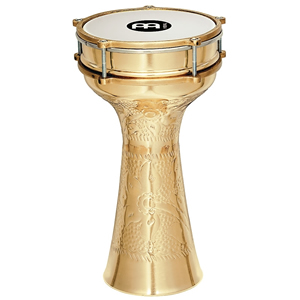What’s the Difference Between Doumbek and Darbuka Drums
As fans of Middle Eastern music and the belly dancers who inspire the “doum-tekka-tek” in our hearts, we’ve often been asked what kind of drum is best to learn these nuanced rhythms and help keep the shimmies going long into the night.
The answer? The doumbek drum.
The other answer? The darbuka drum.
There are never simple answers in drumming. Ever.
Darbuka drums, doumbek drums and even djembe drums are all very similar instruments in terms of the construction, shape and materials used to make the drums. Some say that doumbeks and darbukas are just metal variations of the djembe. Others say that doumbek drums and darbuka drums are shiny and sparkly, keeping up with the elegance and beauty of belly dancers. Djembes tend to have a much warmer tone, and as the size varies, a djembe can be much louder than the doumbek or darbuka, as well. Doumbeks and darbuka drums are much sharper in tone and attack, perfect for close-quarters on stage where the focus is mostly on the dancer, and much less on the drum. Regardless, these drums all have a place in any hand drummer’s arsenal, as we never really know which way the rhythm is going to move us.
But, this isn’t about djembe drums. It’s about darbukas and doumbeks.

Doumbek and darbuka drums are both Middle Eastern hand percussion instruments. They’re both goblet-shaped, and can be used interchangeably in most belly dance or Middle Eastern drumming situations. Neither drum has a definitive role in the music, but, they do have some differences that may matter to the drummer lucky enough to provide the rhythm at the hafla.
Doumbek drums usually stand around 18 inches tall, with a 10-inch drum head. They’re typically found in metal varieties, but, some do prefer the tone that is created by the wooden versions. The shape of the drum shell can vary from an almost djembe-like “goblet” appearance, to a slightly more trimmed down “Y” or “martini glass” shape. Doumbek drums are also pretty ornate in the artistic designs on the shells of the instruments, whether engraved metal, artistic wood staining or hand-painted designs that represent a certain country and/or its culture. The drum head on a doumbek appears to be difficult to access, causing concerns over tuning the drum or repairing or replacing its head. However, a doumbek drum head can tweaked or fixed accordingly, it just takes a bit of patience.
Darbuka drums appear to be a more modern variation of the doumbek. Still goblet-shaped, a darbuka drum is smaller than a doumbek (9-16 inches tall) and is almost always made from metals like copper or aluminum. However, darbuka drums have a drum head that is easier to access than a doumbek. The lugs and rim of the drum are exposed on the outside of the drum, allowing for an easier time with tuning and replacement. This also means that the drum itself has a much sharper sound when hit at the rim.
As with most drums and the differences, the choice between a doumbek and a darbuka drum is a personal one. Both drums are perfect for any type of halfa or belly dance event, and they also blend well with the djembes and bongos in a drum circle.
Recent Posts
-
X8 Drums Play-Along Backing Tracks
The new X8 Play-Along Series is being produced for our musician friends wanting a fresh way to work …9th Feb 2025 -
What is the Best Size Djembe for Beginners?
If you're new to the world of percussion and interested in learning the djembe, you're in for a t …16th Jul 2024 -
The Benefits of Becoming a Drumming Teacher: Transforming Passion into Profession
Why become a drumming teacher? Becoming a drumming teacher is an excellent way to share your pas …22nd May 2024



